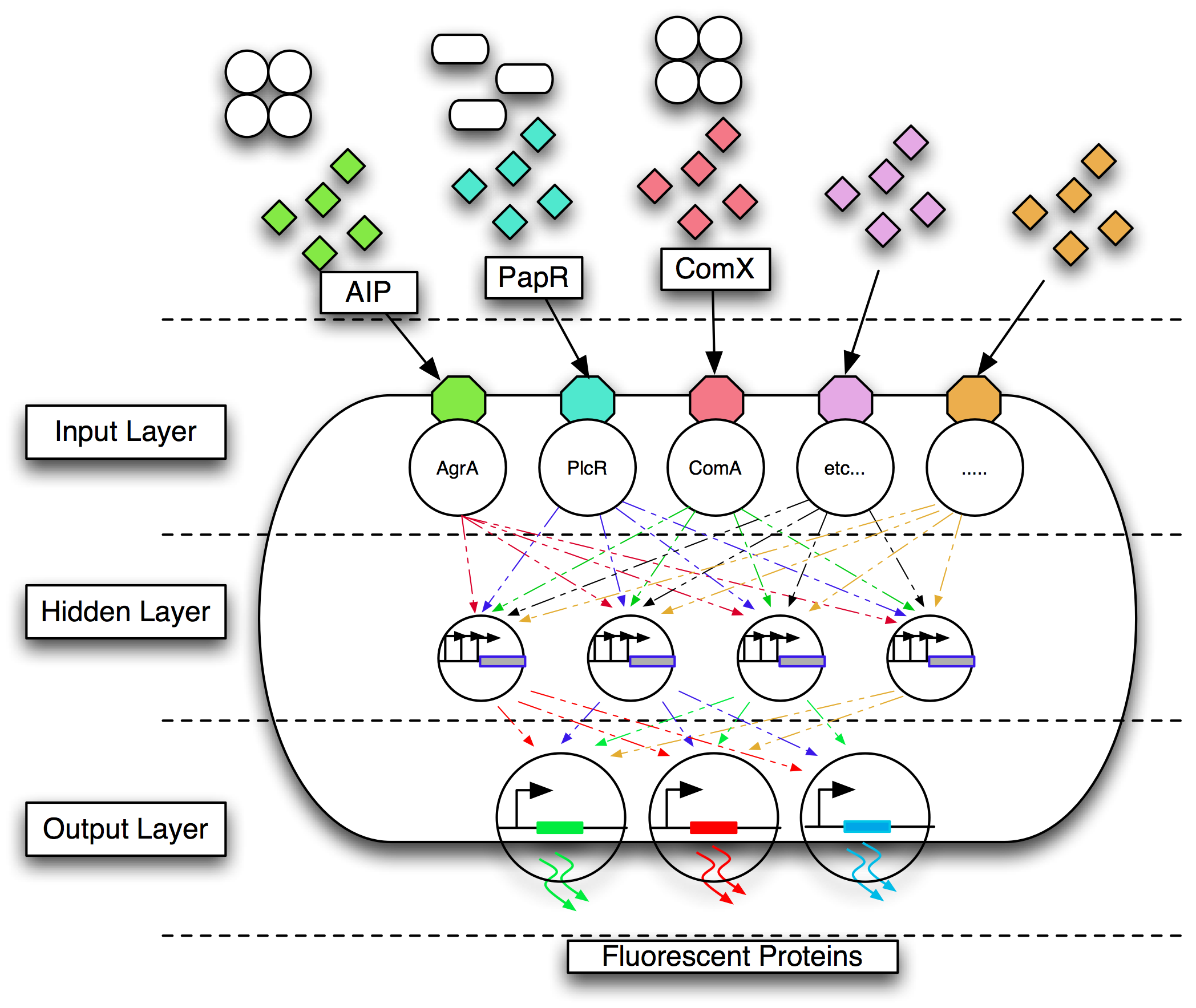Team:Newcastle University/Bug Busters
From 2008.igem.org
| Line 20: | Line 20: | ||
We are developing a diagnostic tool that enables the detection of a range of Gram-positive bacterial pathogens endemic in patients around the world. Currently, detection of these pathogens ranges from a few hours to several days. The system will use genetically engineered ''Bacillus subtilis'', to detect a range of Gram-positive bacterial pathogens. Our principal targets at this stage are ''Staphylococcus aureus'', and ''Streptococcus pneumoniae''. We are also considering the detection of a range of ''Bacillus'' species, and ''Clostridium difficile''. This new system will enable visual detection of these pathogens within minutes. The bacteria will be detected by the specific quorum-sensing peptides that they secrete extracellularly. Detection of the quorum-sensing peptides will activate the expression of fluorescent proteins, viewable under U.V. light, in our engineered ''B. subtilis'' chassis. This application would have importance not only in hospital settings, but also in the third world. | We are developing a diagnostic tool that enables the detection of a range of Gram-positive bacterial pathogens endemic in patients around the world. Currently, detection of these pathogens ranges from a few hours to several days. The system will use genetically engineered ''Bacillus subtilis'', to detect a range of Gram-positive bacterial pathogens. Our principal targets at this stage are ''Staphylococcus aureus'', and ''Streptococcus pneumoniae''. We are also considering the detection of a range of ''Bacillus'' species, and ''Clostridium difficile''. This new system will enable visual detection of these pathogens within minutes. The bacteria will be detected by the specific quorum-sensing peptides that they secrete extracellularly. Detection of the quorum-sensing peptides will activate the expression of fluorescent proteins, viewable under U.V. light, in our engineered ''B. subtilis'' chassis. This application would have importance not only in hospital settings, but also in the third world. | ||
| - | An important part of our approach is bioinformatics. We will produce a [[Team:Newcastle University/Workbench workbench]] that will incorporate a [[Team:Newcastle University/Parts Repository|parts repository]], [[Team:Newcastle University/Constraints Repository|constraints repository]] and an [[Team:Newcastle University/Evolutionary Algorithm|evolutionary algorithm]] (EA). The EA will take input from the parts repository and constraints repository to evolve a neural network simulation. The fittest model will be used to generate a DNA sequence which will implement the neural network in vivo. This DNA sequence will be synthesized and cloned into the ''B. subtilis'' chassis. One of our outcomes will be a range of neural network node BioBrick devices which can be combined to form the ''in vivo'' neural network. | + | An important part of our approach is bioinformatics. We will produce a [[Team:Newcastle University/Workbench|workbench]] that will incorporate a [[Team:Newcastle University/Parts Repository|parts repository]], [[Team:Newcastle University/Constraints Repository|constraints repository]] and an [[Team:Newcastle University/Evolutionary Algorithm|evolutionary algorithm]] (EA). The EA will take input from the parts repository and constraints repository to evolve a neural network simulation. The fittest model will be used to generate a DNA sequence which will implement the neural network in vivo. This DNA sequence will be synthesized and cloned into the ''B. subtilis'' chassis. One of our outcomes will be a range of neural network node BioBrick devices which can be combined to form the ''in vivo'' neural network. |
Revision as of 06:59, 26 August 2008
Newcastle University
GOLD MEDAL WINNER 2008
| Home | Team | Original Aims | Software | Modelling | Proof of Concept Brick | Wet Lab | Conclusions |
|---|
Bug Busters
We are developing a diagnostic tool that enables the detection of a range of Gram-positive bacterial pathogens endemic in patients around the world. Currently, detection of these pathogens ranges from a few hours to several days. The system will use genetically engineered Bacillus subtilis, to detect a range of Gram-positive bacterial pathogens. Our principal targets at this stage are Staphylococcus aureus, and Streptococcus pneumoniae. We are also considering the detection of a range of Bacillus species, and Clostridium difficile. This new system will enable visual detection of these pathogens within minutes. The bacteria will be detected by the specific quorum-sensing peptides that they secrete extracellularly. Detection of the quorum-sensing peptides will activate the expression of fluorescent proteins, viewable under U.V. light, in our engineered B. subtilis chassis. This application would have importance not only in hospital settings, but also in the third world.
An important part of our approach is bioinformatics. We will produce a workbench that will incorporate a parts repository, constraints repository and an evolutionary algorithm (EA). The EA will take input from the parts repository and constraints repository to evolve a neural network simulation. The fittest model will be used to generate a DNA sequence which will implement the neural network in vivo. This DNA sequence will be synthesized and cloned into the B. subtilis chassis. One of our outcomes will be a range of neural network node BioBrick devices which can be combined to form the in vivo neural network.
 "
"


